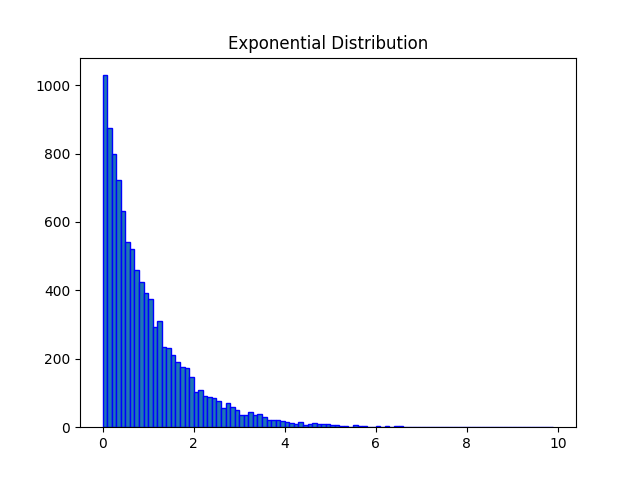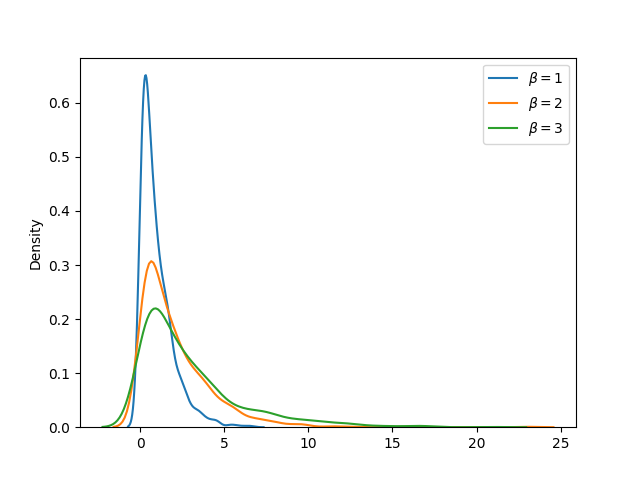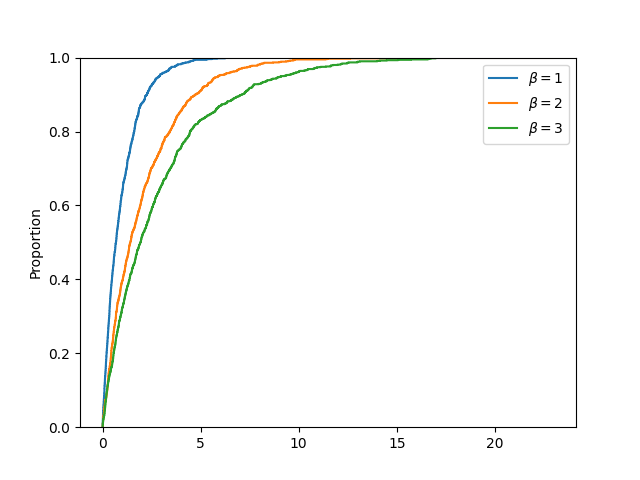NumPy - Exponential Distribution
Exponential distribution is the probability distribution of the time between events in a Poisson point process, i.e., a process in which events occur continuously and independently at a constant average rate. It is a particular case of the gamma distribution. For example, customers arriving at a store, file requests on a server etc.
The probability density function (pdf) of exponential distribution is defined as:

Where, β is the scale parameter which is the inverse of the rate parameter λ = 1/β.
An exponential distribution has mean β and variance β2.
The cumulative distribution function (cdf) evaluated at x, is the probability that the random variable (X) will take a value less than or equal to x. The cdf of exponential distribution is defined as:

The NumPy random.exponential() function returns random samples from a exponential distribution.
Syntax
numpy.random.exponential(scale=1.0, size=None)
Parameters
scale |
Optional. Specify the scale parameter, β = 1/λ. float or array_like of floats. Must be non-negative. Default is 1.0. |
size |
Optional. Specify output shape. int or tuple of ints. If the given shape is (m, n, k), then m * n * k samples are drawn. If size is None (default), a single value is returned if scale is a scalar. Otherwise, np.array(scale).size samples are drawn. |
Return Value
Returns samples from the parameterized exponential distribution. ndarray or scalar.
Example: Values from exponential distribution
In the example below, random.exponential() function is used to create a matrix of given shape containing random values drawn from specified exponential distribution.
import numpy as np size = (5,3) sample = np.random.exponential(1, size) print(sample)
The possible output of the above code could be:
[[0.71318134 0.51261985 2.21255627] [0.38593481 0.54545811 0.39075276] [0.56583485 1.59475025 0.13879821] [0.82487244 0.20735562 1.33014896] [0.21085364 1.06640552 1.33323175]]
Plotting exponential distribution
Example: Density plot
Matplotlib is a plotting library for the Python which can be used to plot the probability density function (pdf) of exponential distribution using hist() function.
import matplotlib.pyplot as plt
import numpy as np
#fixing the seed for reproducibility
#of the result
np.random.seed(10)
size = 10000
#drawing 10000 sample from
#exponential distribution
sample = np.random.exponential(1, size)
bin = np.arange(0,10,0.1)
plt.hist(sample, bins=bin, edgecolor='blue')
plt.title("Exponential Distribution")
plt.show()
The output of the above code will be:

Example: Comparing pdfs
Multiple probability density functions can be compared graphically using Seaborn kdeplot() function. In the example below, pdf of three exponential distributions (with scale factor 1, 2 and 3 respectively) are compared.
import numpy as np
import matplotlib.pyplot as plt
import seaborn as sns
#fixing the seed for reproducibility
#of the result
np.random.seed(10)
size = 1000
#plotting 1000 sample from
#different exponential distribution
sns.kdeplot(np.random.exponential(1, size))
sns.kdeplot(np.random.exponential(2, size))
sns.kdeplot(np.random.exponential(3, size))
plt.legend([r"$\beta = 1$",
r"$\beta = 2$",
r"$\beta = 3$"])
plt.show()
The output of the above code will be:

Example: Comparing cdfs
Multiple cumulative distribution functions can be compared graphically using Seaborn ecdfplot() function. In the example below, cdf of three exponential distributions (with scale factor 1, 2 and 3 respectively) are compared.
import numpy as np
import matplotlib.pyplot as plt
import seaborn as sns
#fixing the seed for reproducibility
#of the result
np.random.seed(10)
size = 1000
#plotting 1000 sample from
#different exponential distribution
sns.ecdfplot(np.random.exponential(1, size))
sns.ecdfplot(np.random.exponential(2, size))
sns.ecdfplot(np.random.exponential(3, size))
plt.legend([r"$\beta = 1$",
r"$\beta = 2$",
r"$\beta = 3$"])
plt.show()
The output of the above code will be:



